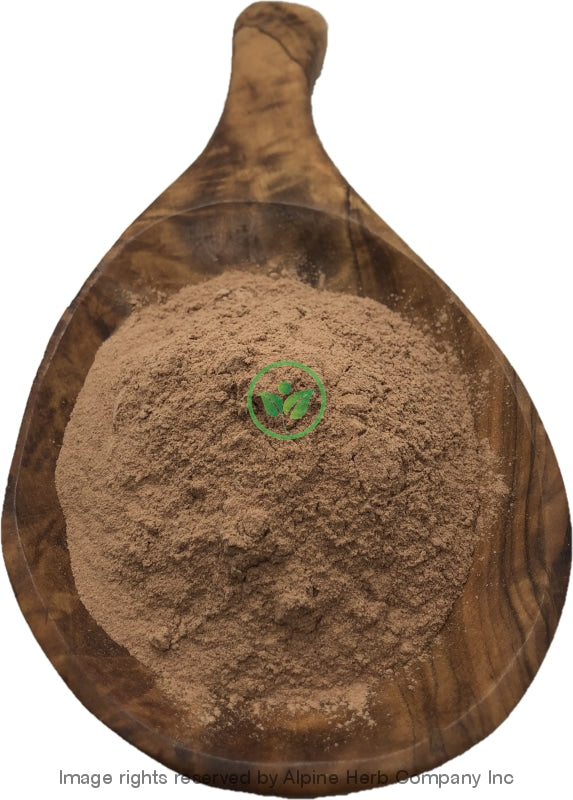Arjuna Terminalia Bark Powder Alpine Herb Company Inc.
$ 9,49 $ 5,69
Botanical Name: Arjuna Terminalia
Common Name:
- English: Arjuna
- Ayurvedic: Kakubha, Svetavaha
- Unani: Arjun
- Also, known as: Marudam, Viravriksha, Kakubha, Arjun, Sajada, Maddi, Arjon, Sadada, Sadad, Aartagala, Dhananjaya, Paartha, Kaakubha, Indravriksha, Torematti, Nirmasuthu, Kudare, kivimase, Neermatti, Matti, Mattimora, Vellamaruthi, Marudam, Bilimatti, Mathichakke, Kumbuk, Neer Maruthu, Marudha maram, Thella maddi, Abhaya, Amandier Indien, Amandier Tropical, Arale, Arjan des Indes, Arjuna, Axjun Argun, Badamier, Badamier chebule, Badamier Géant, Baheda, Bahera, Bala Harade, Balera, Behada, Beleric Myrobalan, Belleric Myrobalan, Belliric Myrobalan, Bhibitaki, Bibhitak, Bibitaki, Black myrobalan, Carambole Marron, Chebulic Myrobalan, Chebulische, Dhavala, Gall nut, Gallnut, Hara, Harad, Harada, Harade, Haritaki, Haritali, Harra, Harro, He li le, He Zi, Hirala, Indian Almond, Indian gall nut, Indian gallnut, Indian gall-nut, Indradru, Ink nut, Jangalii harro, Kadukka, Kadukkai, Kadukkaya, Kakubha, Kalidruma, Karkchettu, Karshaphala, Kumbuk, Manja lawai, Mirobalanos índicos, Mirobaran no ki, Myrobalan, Myrobolan Bellirique, Myrobolan Chébule, Myrobalanenbaum, Nadisraja, Partha, Pathya, Rispiger, Terminalia arjuna, Terminalia bellirica, Terminalia chebula, Terminalia chebulic, Thuulo harro Tropical Almond, Veeravriksha, Vibhitaki.
Origin: India
Harvested: Wild
Parts Used: Bark
General Information:
Arjuna is a very common plant in the tropical regions of the world, mainly India. It can reach up to a height of 20-25 meters. Arjun is a large-sized deciduous evergreen tree with very strong and long roots. Leaves are conical, dull green above and pale brown beneath, with yellow flowers and grey colored smooth bark. It has a glabrous, fibrous woody, 2-4 cm long fruit with five hard wings and a number of curved veins.
It is one of the few herbal medicines that has been recognized by all medical fields be it modern medicines, Ayurveda, homeopathy, or functional medicine.
The reddish bark of the plant is the main useful part but, other parts of this majestic tree are also used for treatment.
Arjuna is very well known and recognized by Ayurveda from ancient times and nowadays accepted and popular worldwide.
How to use:
Powdered Herb:
There are different ways to use powdered herb.
Food Preparation: You can add powdered herb to any super food herbal smoothie, sauces, spreads and even cookies. Also for children, you can mix powdered herb with honey or glycerin to make paste. The thicker the paste, the more potent and herbal in taste. The sweet taste of honey and glycerin will help medicine go down. This method is also known as “Electuaries”.
Capsules: Encapsulating your own powdered herb at home, gives you assurance that the contents of the capsules are pure herb and no filler or any other products. These capsules can be taken with liquid.
Poultice: Poultice can be made with an herbal powder and liquid (mostly water) to form a paste which is then applied to the skin. This method is very helpful for skin conditions.
Herbal shot: Powdered herb can be mixed with water, fruit juice or other liquid to make herbal shot.
Precautions:
You should consult with a qualified healthcare practitioner before using any herbal products, particularly if you are pregnant, nursing, or on any medications.
All information on this website is for educational purpose ONLY
This information has not been evaluated by Health Canada.
This information is not intended to diagnose, treat, cure, or prevent any disease.
| Unit Size | 100g, 200g, 400g, 1kg |
|---|
Prompt shipping and expert packing
Thanks to our longstanding association with UPS FedEx DHL as well as other leading global carriers, we can offer a variety shipping options. Our warehouse staff is highly trained and will be able to pack your goods in accordance with our precise and exact specifications. Your items will go through an exhaustive examination before they will be securely packaged before being delivered. We ship to hundreds of thousands of customers daily in different countries. This is a sign of our determination to become the largest online retailer worldwide. Warehouses and distribution centers are located throughout Europe as well as in the USA.
Note that orders containing multiple items are processed according to the particular item.
We will thoroughly inspect all items ordered before shipping. Most orders are shipped within 48 hours. The delivery time will be between 3 and 7 working days.
Returns
The stock market is always changing. It's not entirely managed by us since we're involved with several entities, including the factory and the storage. Therefore, the actual inventory could fluctuate at any moment. Please be aware that it is possible that your order could be out of stock after you've placed your order.
Our policy lasts for 30 days. If it's been more than 30 days since the date you purchased your item We're sorry to say that we can't offer you a full exchange or refund.
You can only return a product if it is unused and still in the same state as when you received it. The item should be in the original packaging.
Related products
Herb Powder
Herb Powder
Herb Powder
Herb Powder
Herb Powder
Herb Powder
Herb Powder
Herb Powder
Herb Powder
Herb Powder
Herb Powder
Herb Powder
Herb Powder
Herb Powder
Herb Powder
Herb Powder
Herb Powder
Herb Powder
Herb Powder
Herb Powder


































